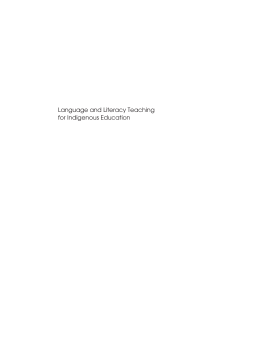
BOOK
Language and Literacy Teaching for Indigenous Education
Dr. Norbert Francis | Jon Reyhner
(2002)
Additional Information
Book Details
Abstract
Language and Literacy Teaching for Indigenous Education: A Bilingual Approach presents a proposal for the inclusion of indigenous languages in the classroom. Based on extensive research and field work by the authors in communities in the United States and Mexico, the book explores ways in which the cultural and linguistic resources of indigenous communities can enrich the language and literacy program.
Norbert Francis teaches courses in language learning and language teaching at Northern Arizona University. He has worked as a bilingual immersion teacher in the United States and in bilingual indigenous community schools in Mexico. His primary interests lie in the study of child language development, second language learning, and biliteracy.
Jon Reyhner is currently professor of Bilingual/Multicultural Education at Northern Arizona University. Formerly co-ordinator of the Indian Bilingual Teacher Training Program at Montana State University-Billings, he has worked as a teacher and school administrator in Indian community schools in Arizona, Montana and New Mexico. His research interests include improving the academic achievement of American Indian students and indigenous language revitalization.
Table of Contents
| Section Title | Page | Action | Price |
|---|---|---|---|
| Contents | v | ||
| Preface | vii | ||
| Abbreviations | ix | ||
| Part 1 A Survey of Indigenous Languages in Education in the Americas | 1 | ||
| Chapter 1 Prospects for Learning and Teaching Indigenous Languages | 3 | ||
| Chapter 2 State of the Languages | 20 | ||
| Chapter 3 Language Policy and Language Planning: The Role of the School and Indigenous Language Literacy | 41 | ||
| Part 2 Curriculum and Materials, Classroom Strategies | 67 | ||
| Chapter 4 Promoting Additive Bilingual Development | 69 | ||
| Chapter 5 The Bilingual Classroom | 104 | ||
| Chapter 6 Biliteracy: Teaching Reading and Writing in the Indigenous Language | 131 | ||
| Chapter 7 Language Assessment | 160 | ||
| Chapter 8 Conclusion: A Teaching Model for Realizing the Potential of Additive Bilingualism | 188 | ||
| Chapter 9 Resources for Schools and Communities | 195 | ||
| Notes | 201 | ||
| Glossary | 225 | ||
| Appendix A | 236 | ||
| Appendix B | 239 | ||
| Appendix C | 243 | ||
| Appendix D | 245 | ||
| Appendix E | 247 | ||
| References | 253 | ||
| Index | 270 |
